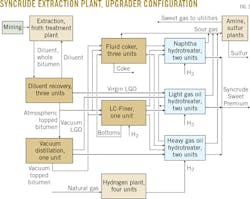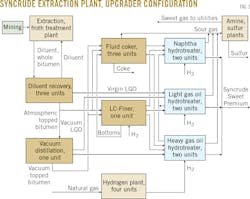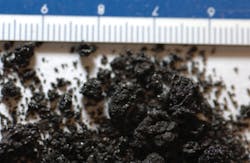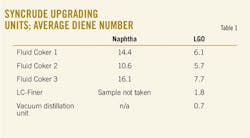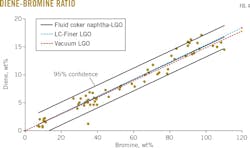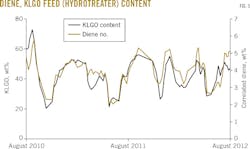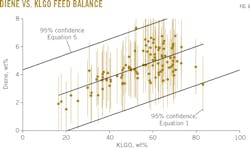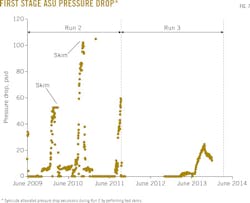Feed-monitoring strategy improves hydrotreater reliability
Jason Wiens
Craig McKnight
Andre Taguinod
Wayne Schiewe
Syncrude Canada Ltd.
Syncrude Canada Ltd. has devised and implemented a feedstock monitoring strategy to prevent the reemergence of popcorn coke that previously caused several production outages of a light gas oil (LGO) hydrotreater at its 350,000-b/d oil sands operations in Fort McMurrary, Alta.
To understand the potential for hydrotreater fouling, Syncrude sampled the hydrotreater's LGO and naphtha blending streams, identifying a relationship between diene and bromine numbers.
Using this relationship, Syncrude developed separate equations to minimize the formation of popcorn coke foulant by establishing the maximum bromine number and coker LGO (KLGO) content allowable in hydrotreater feed.
Syncrude's processes
Syncrude's production of Syncrude Sweet Premium (SSP) crude oil from western Canadian oil sands involves a series of processes, including mining, extraction, froth treatment, upgrading, secondary upgrading, and blending.
After its separation from sand during the extraction and froth treatment stages, resulting bitumen moves to the upgrader for primary conversion. The upgrader features three fluid coking units and one LC-Fining hydrocracking unit. Once the bitumen's naturally occurring LGO component and diluent naphtha have been recovered, these streams go to secondary upgrading units, which include two heavy gas oil hydrotreaters, two LGO hydrotreaters, and two naphtha hydrotreaters.
The two LGO hydrotreaters, however, differ in terms of both feed and function. One unit features single-stage hydrotreating and mainly is used for hydrodenitrification (HDN) and hydrodesulfurization (HDS) of virgin LGO and vacuum LGO feed.
The second hydrotreater, or the aromatics saturation unit (ASU), works in two stages. The first stage primarily involves HDS and HDN, with the second stage designed to maximize aromatics saturation. This hydrotreater receives a feed blend of coker, LC-Finer, treated, and vacuum LGO.
Fig. 1 shows the configuration of Syncrude's extraction and upgrading operations.
Unplanned outages
Syncrude's ASU completed its inaugural 3-year operational run from September 2006 to April 2009 without interruptions. After months 9 and 17 during its second operating cycle, the ASU began to exhibit large drops in first-stage bed pressure that required feed outages.
To alleviate pressure drop, Syncrude performed skims of the top catalyst bed. Subsequent analysis of the bed samples showed that the deposition of popcorn coke formed by polymerization of diolefins led to the pressure drop.
A variety of operating conditions can favor the formation of popcorn coke.1 Temperatures in the 232-324° C. range are required for the polymerization reaction to occur. At temperatures below this range, the polymerization reaction takes place too slowly to cause fouling. At temperatures above this range, depolymerization dominates.
The second process condition conducive to formation of popcorn coke is the presence of a sufficiently high concentration of conjugated diolefins. Significant fouling typically occurs when feed diene numbers above 4 g I/100 g are found using Universal Oil Products Collection (UOP) method 326-82.1
Though Syncrude routinely performs testing of the bromine number (essentially a measure of the concentration of mono-olefins) in feed sent to its LGO hydrotreaters, little analysis or monitoring of the feed's diene content was done before the bed pressure drops that led to ASU feed outages.
The average time to run an analytical diene number test and receive its results is about 5 hr. Measuring the diene number of the ASU's direct feed via standard analytical methods would not provide information quickly enough to also monitor the operation. Syncrude, as a result, organizing a sampling campaign to measure the bromine and diene numbers of the source LGO and naphtha found in the upgrader. Based on these data, the team developed correlations that evaluate the polymerization potential of LGO feed. The first correlation relates fouling potential to the measured bromine number, while the second relates fouling potential to KLGO content.
Fouling mechanism
Foulant-sample recovery occurred during the March 2010 bed skim of a heat exchanger filter, hydrotreater top tray (Fig. 2), and top catalyst bed. Samples were tested to determine the fouling mechanism.
Syncrude determined the foulant had a hydrogen-to-carbon ratio of 0.69 to 0.92. It was also isotropic when viewed under polarized light. These sample characteristics were consistent both with those of popcorn coke1 and with Syncrude's past experience, allowing investigators to positively identify popcorn coke formed through polymerization of diolefins in the ASU feed as the cause of fouling. This mechanism was confirmed through observation during a 2011 plant turnaround.
Each preheat train in the ASU uses three heat exchangers in series to heat the feed to 300° C. from about 110° C. before final heating by an associated furnace.
The 2011 turnaround included opening and cleaning all heat exchangers. During cleaning, a peculiar trend emerged: in all cases, the first of three heat exchangers was spotlessly clean, while the second and third were heavily fouled (Fig. 3).
The temperature of foulant formation in the heat exchangers was consistent with the threshold temperature range for popcorn coke formation (232-324° C.),1 confirming the investigation team's conclusion that fouling was a result of popcorn coke. Data showed that popcorn coke was formed in the heat exchangers, where it eventually spalled off and was entrained into the catalyst bed.
Sampling
Syncrude continued to collect weekly samples of LGO from its fluid cokers (FLK), LC-Finer, and vacuum distillation unit (VDU), as well as naphtha from the FLKs. All samples were nitrogen-blanketed, and exposure to sunlight was avoided.
Alberta Innovates, Edmonton, Alta., analyzed the samples' diene (performed by UOP-326-82) and bromine (performed by ASTM D-1159) content.
Diene, bromine number
Relative to the KLGO, the LC-Finer and VDU LGO contained only a small concentration of diolefins. Syncrude expected this, as virgin material from the VDU should be relatively saturated, and hydrogenation reactions should suppress diolefin formation in the LC-Finer.
Table 1 summarizes diene number data of samples collected from Syncrude's primary upgrading units.
Results showed there was variation in measured diene values of KLGO from the three FLK units, which typically stems from differences in feed distillation to the units. The sources of KLGO containing progressively lower diene numbers were units fed progressively higher fractions of atmospheric-topped bitumen (ATB), which contained approximately 10% virgin LGO at the time of sampling.
The concentration of diolefins (estimated with diene number) and monoolefins (estimated with bromine number) are not generally correlated. Because mono- and diolefins are derived from the cracking of bitumen pitch in Syncrude feed, Syncrude determined correlation between the two may be possible.
Fig. 4 shows the relationship between the diene and bromine numbers for fluid coker, LC-Finer, and virgin LGO, as well as for coker naphtha.
Equation 1 describes the data's linear relationship.
The 95% confidence limit of the correlated diene number is 2σD=±2.0 g I (grams of iodine)/100 g. The correlation describing the diene-bromine ratio is essentially the same whether exclusively LGO or naphtha data. LGO-naphtha combined data are used to correlate diene and bromine numbers.
Equation 1 offers the first tool for monitoring the fouling potential of the hydrotreater feed, using the bromine number as a surrogate for the diene number.
Because unit operation must remain below the threshold diene number to limit fouling (defined here as the minimum diene number where polymer formation is significant enough to cause fouling), the maximum bromine number that should be measured in the hydrotreater feed stream is obtained by subtracting the correlation uncertainty using Equation 2.
Defining a threshold diene number, ND,thresh , allows establishment of the maximum bromine number that can be measured in the feed stream without risking significant fouling, NBr,meas,thresh.
KLGO content-to-fouling
The correlated diene number (obtained from Equation 1) and the KLGO content in the hydrotreater feed are generally well correlated (Fig. 5).
Fig. 6 presents the relationship between the correlated diene number and the KLGO content in the ASU feed. Equation 3 crudely describes this relationship. Syncrude determined the uncertainty in the fit of this correlation to the correlated diene number to be 2σKLGO = ±1.8 g I/100 g, showing that correlating the diene number solely to the KLGO content in the hydrotreater feed is an oversimplification. The correlation, for instance, assumes the content of LC-Finer LGO is constant in the feed, as it has a different diene number than virgin LGO. Syncrude also noted that the correlation does not account for the effect of feed distillation on the FLKs, which can have a substantial impact on diene content.
But because the correlation in Equation 2 encompasses an extended operating history-more than 2 years of operating data-these variations in plant operation would be accounted for in the calculated uncertainty.
A simple combination of uncertainties determines the statistical limit on KLGO blending. The uncertainty in the relationship established by Equation 2 is a composite of two individual uncertainties: the uncertainty in the correlation between the historical hydrotreater diene number data and the percentage of KLGO used in blending Plant 18-2 feed (Equation 2), and the uncertainty in Equation 1 used to correlate the diene number from the measured bromine number.
Equation 4 combines these uncertainties.
From Equation 4, a combined total uncertainty of 2σcorr=2.7 g I/100 g. (95% confidence interval) is calculated for correlating the diene number from the percentage of KLGO in hydrotreater feed (Fig. 3).
Syncrude used the total uncertainty calculated by Equation 4 to establish KLGO blending limits for the ASU feed. The diene number to target to minimize foulant production was determined by rearranging Equation 2 with total correlation uncertainty (Equation 5).
Determining a threshold diene content, ND, thresh , above which polymerization is deemed significant established a safe operating envelope. The investigation team determined fouling due to diolefin polymerization should be manageable if the percentage of KLGO calculated in Equation 5 was not exceeded.
Implementation
As part of Syncrude's production plan, the maximum KLGO content in the feed (Equation 5) is targeted, while the maximum measured bromine number of the feed (Equation 2) is an absolute limit.
Fig. 7 presents the pressure drop across the top bed of the ASU for the operating cycles before and after implementation of the new operating envelopes. The run prior to implementation (Run 2) demonstrated pressure drop excursions after 9 and 16 months-requiring bed skims to regain operability-as well as a critical pressure drop by the end of the 2½-year run.
The new operating envelopes were implemented at the beginning of Run 3. Adhering to the operating envelope established by the sampling correlations allowed Syncrude to prevent the reemergence of popcorn coke in the LGO hydrotreaters.
Although only sporadic Run 3 pressure-drop data are available (Fig. 7), the ASU was able to achieve its targeted 3-year run cycle without interruption before entering a scheduled spring 2014 turnaround.
Acknowledgments
The authors thank Peter Ronan, Sherry Noyes, and John Adjaye for their assistance in this work.
References
1. Wiehe, I.A., "Mitigation of the fouling by popcorn coke," Petroleum Science & Technology, Vol. 21, No. 3-4, 2003, pp. 673-680.
The authors
Jason Wiens ([email protected]) is a senior engineer in research and development at Syncrude Canada Ltd., where he serves as project leader for the fluid coker reliability improvement project. He holds a PhD (2010) in chemical engineering and BS (2005) in chemical engineering with a specialization in biotechnology, both from the University of Saskatchewan, Saskatoon. Jason is a member of APEGA.
Craig McKnight ([email protected]) has 28 years' experience at Syncrude Canada Ltd., where he serves as senior technical associate for Syncrude Research and Development. He has been responsible for research projects in all areas of Syncrude's upgrading operations. McKnight holds an MS (1987) and BS (1984) in chemical engineering from Queen's University, Kingston, Ont., and is a member of the Association of Professional Engineers and Geoscientists of Alberta (APEGA).
Andre Taguinod ([email protected]) joined Syncrude Canada Ltd. in 2005 after earning his BS in chemical engineering from the University of Calgary, Calgary, Alta. At Syncrude, he worked as an operations support engineer in off sites, gas treating, and hydrotreating. Since 2014, Andre has been on a developmental assignment as a hydroprocessing engineer at ExxonMobil Research and Engineering Co.'s Canadian engineering office. Andre is a registered professional engineer in Alberta.
Wayne Schiewe ([email protected]) is now retired from his position as senior technical advisor for Syncrude Canada Ltd. He held a number of senior technical and leadership positions within Syncrude in the bitumen processing operations area, as well as in research and development. Wayne holds a BS (1978) in chemical engineering from the University of Alberta, Edmonton, Alta., and is a member of APEGA.
